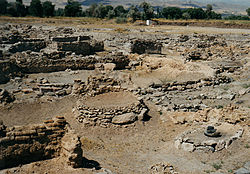Assyria

Assyria was a city-state on the Upper Tigris River in the Middle Bronze Age. It was named after its capital, the ancient city of Assur.
The Assyrians were just to the north of their rivals, the Babylonians. All of the kingdoms of ancient Mesopotamia used the cuneiform writing system, which had been invented by the Sumerians.
Assyrian people
The Assyrians are an ethnic group whose descendants remain in what are now Iraq, Iran, Turkey, and Syria, but many have immigrated to the Caucasus, North America, and Western Europe during the past century. Hundreds of thousands more live in the Assyrian diaspora. They are part of the Iraqi refugees communities in Europe, the former Soviet Union, the United States, Australia, New Zealand, Syria, Jordan, and Lebanon.
Assyria Media
The head of a female statue, dating back to the Akkadian period (c. 2334–2154 BC). Found at Assur, display at the Pergamon Museum in Berlin.
The ruins of the Old Assyrian trading colony at Kültepe





